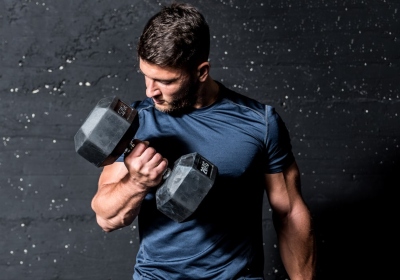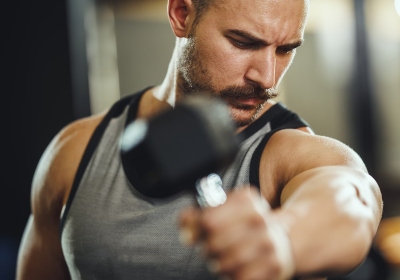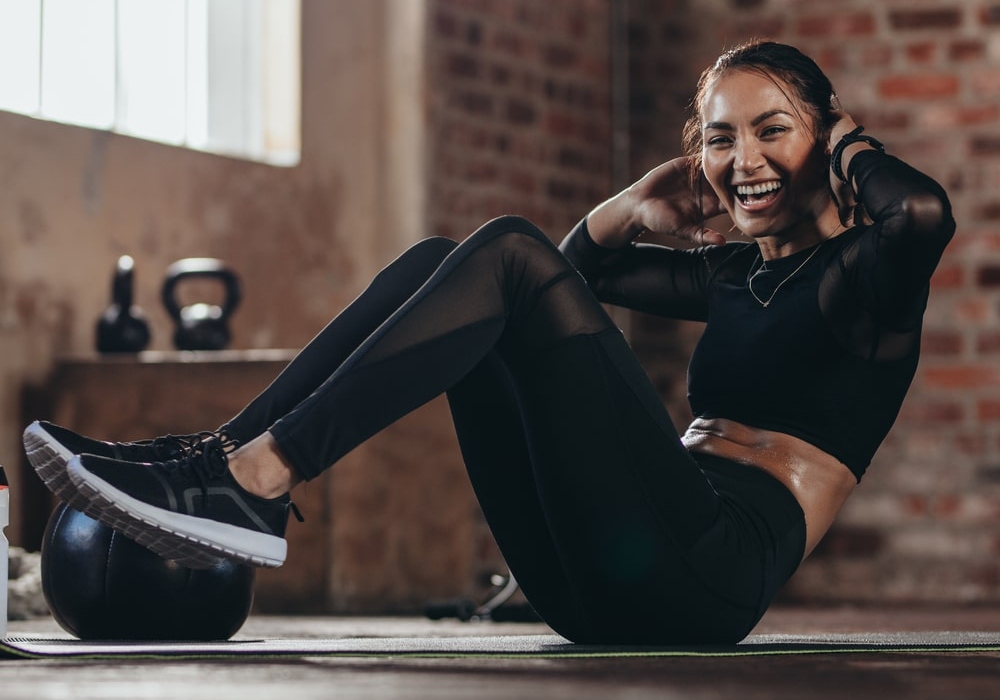VIDEO
Dumbbell Bent Over Row
- Biceps
- Trapezius
- Upper Back
- Shoulders
- Obliques
- Chest
Level:Intermediate
Trainer:Nick Taylor
Equipment:Dumbbell
Dumbbell Bent Over Row
- Biceps
- Trapezius
- Upper Back
- Shoulders
- Obliques
- Chest
Level:Intermediate
Trainer:Nick Taylor
Equipment:Dumbbell
Stand tall with dumbbels in your hands and your feet closer that shoulder-width apart. Keeping your back straight, incline your torso slightly forward. And lift the weights up to the chest, bending your elbows. Make sure that your movements are smooth and your back isn't round. Otherwise, the weights will seem heavy. Then, slowly lower your hands, getting back to the starting position.
save to ...
RECOMMENDED FOR YOU
ARTICLES
Biceps is the most famous muscle in the human muscular system, it is approximately one-third of the mass of the shoulder. It is a part of a group of three in the upper arm that works together with each other to lift the arm toward the shoulder. As one of the most visible and impressive parts of the body, “two-headed muscles” are often the gym’s focus.
It is responsible for two main movements of the arm. The first is raising your hand. Those who carry something using their arm are likely to engage them in the process, as some upward force must be applied during the process of carrying and lifting. The second movement, for which they are responsible, is called supination, which rotates the arm from the natural position of the palm down to the palm up.
Biceps are built as a result of injury, which is often achieved through lifting weights such as curls or other types of exercises. As the curls or other exercises are done, the muscles in the arm get minor injuries. These injuries must be repaired naturally. The recovery process, as a natural byproduct, usually leads to growth and strength gains, although this process can take several weeks or months before noticeable results are seen.
Very few exercises work for it without affecting the other parts of the shoulder. Therefore, there is no reason to worry that others in the upper arm might be neglected by focusing on them. Some may focus only on the arm and almost completely forget about the legs or the core.
As one of the most commonly used muscles in the body, the biceps can certainly be damaged. Biceps injuries are not as common as some other types of injuries, there is always a risk, especially among weightlifters. The most common type of injury is damage to the tendon. In this type of injury, It is pulled away from the tendon that attaches it to the arm in a bone also known as the radius. Such injuries occur when they are used suddenly or to a level that they cannot handle.
Training.
Dumbbell Bicep Curls. Stand straight with the dumbbell in each hand and with your feet shoulder-width apart. Once the dumbbells are at your shoulder level, start slowly lower your arms to the starting position. Repeat for the desired amount of repetitions.
Incline Pushup. Place your hands slightly wider than shoulder-width apart on a bench, chair, or couch. And assume a high plank position with your feet together and your body straight from head to heels. Keeping your feet flat and core engaged lower your chest to the bench or chair. Pause. And then push yourself back up to the starting position.
Diamond Knee Pushup. With your knees on the ground place your hands on the ground with your fingers and thumbs touching together creating the diamond shape. This action will engage more your tricep muscle. Then complete a push-up and get back to the starting position. Repeat for the desired number of repetitions.
Pike Pushup. Assume a shorter push-up position, get on your toes and put your butt up, shifting your weights to the front. Bending your arms slowly lower your head, be sure not to bump your head on the ground.
Read more
The shoulder muscles are divided into two groups. The anterior group consists of flexors: the coracohumeral, the brachialis, and the biceps brachii. The posterior group includes the extensors: the triceps brachii and ulnar.
The coracohumerals start from the coracoid process of the scapula fuses with the short head of the biceps brachii and pectoralis minor and attaches to the humerus at the level of the upper edge of the brachial.
The brachials start from the lower half of the anterior surface of the humerus and the intermuscular septa of the shoulder and attach to the tuberosity of the ulna and its coronal process.
The biceps brachii has two heads starting on the scapula from the supra-articular tubercle (long head) and the coracoid process (short head). It attaches to the forearm to the tuberosity of the radius and the fascia of the forearm. It belongs to the bicarticular part. Concerning the shoulder joint, the biceps of the shoulder is the flexor of the shoulder, and the elbow is the flexor and instep support of the forearm.
The triceps brachii is located on the back of the shoulder, has three heads, and is a bicarticular. It participates in the movements of both the shoulder and the forearm, causing extension and adduction in the shoulder joint and extension in the elbow.
The ulnar starts from the lateral epicondyle of the humerus and radial collateral ligament and the fascia; it is attached to the upper part of the posterior surface and partly to the olecranon of the ulna in its upper quarter. The function of this is to extend the forearm.
The bundles of the deltoid muscle perform different functions, so it will not work to load them all with one exercise: you will have to include at least three movements in the training. All exercises are divided into three parts: for pumping the front, middle and back beams. Pick exercises from our list below and add them to your workouts. The weight is necessary so that the last repetitions in the approach are given not easily, but without compromising the technique. You can train your shoulder straps both at home and in the gym. But it is necessary to have a bar and a gantry. Weight must be chosen in such a way that in every set it was possible to raise the average 8-10 times. This is how you can increase the volume and mass. If the same goal is set - to increase the strength, to train in the face of more severe conditions. In this case, the number of repeats will be 5-8. The number of reps is 4-5.
Barbell bench press. Take the shell on your chest, bring your elbows forward, tighten your abs, buttocks, legs. Squeeze the bar up, lower it back and repeat. When the bar passes your face, do not lift your chin, but squeeze it in yourself: this way the bar will go along the optimal trajectory. If the projectile remains in front of the body at the top point, and not above it, the load on the lower back increases. Therefore, try to take the barbell behind your head.
Standing dumbbell press. Raise your arms with the selected weight to shoulder level, turn your palms forward with your fingers. Squeeze the dumbbells up and take them slightly behind your head, and then lower them to the starting position and repeat. Do three to five approaches 10-12 times.
Seated Bent-Over Dumbbell Routing. Sit on a bench, tilt your body with a straight back, as far as flexibility allows, hold the dumbbells in your lowered hands. Without changing the position of the body, spread your arms with the taken weight on the sides to shoulder level. Slowly lower the dumbbells to the starting position and repeat.
Read more
The oblique abdominal muscles are several groups of abdominal muscles on the sides of the core. The external oblique muscle lies on top and the internal oblique muscle - below it. Functional exercises for training them are bending, turning to the sides, and other rotating movements.
However, in order to work your obliques properly, you must remember that most exercises for the oblique muscles involve the other abdominal muscles, the inner transverse muscles, in particular. That's why you need to be able to consciously engage certain areas of the abs during the workout.
The oblique muscles represent the lateral part of the abdominal area. They act as the main rotators of the body. They are represented by two separate muscles, depending on depth and layer:
The outer oblique abdominal muscle forms the superficial layer. It is usually the target of training. It anatomically begins from ribs 5-12.
The internal muscle originates from the lumbosacral fascia, iliac crest, and inguinal ligament. It is attached to the area of the white line, cartilages of ribs 9-12, and pubic crest.
The main task of the oblique abs is to rotate the torso. Although, in addition to the main one, the muscle performs a number of functions:
Tilting of the torso.
Flexion.
Lowering the ribs.
The tension of the anterior abdominal chest wall.
Bilateral contraction.
In general, in order to work your abs properly, it is necessary to follow simple recommendations:
Eat lightly 2-2.5 hours before the exercise. If you train with an empty stomach, you will not work out to your full potential, which means that the workout will be ineffective. An overfilled stomach can also leave negative consequences, such as nausea and severe dizziness.
Warm up your muscles by doing light exercises. Jump, run on the spot or on a machine, do simple tricks like turns, twists, and turns.
Do not overdo it! You don't need to exhaust yourself every day. Try 2-4 times a week - that will be enough for a nice and shapely belly.
Each exercise should stretch your muscles. You should feel how they are tensed. If this is not there, then you are doing something wrong.
Do not eat immediately after the workout. If you feel very hungry, snack on an apple or drink a glass of water. Do not eat after one hour at the earliest.
Read more
The most important muscles in the upper back are the lats and trapezius.
Lats (Latissimus dorsi). Shaping muscles of the back, giving the figure a tapered appearance. Visually widen the shoulders and make the waist appear narrower. They are located on both sides of the spine, and their shape resembles a wing.
Trapezius muscles. These are the muscles that need to be trained if you want to correct the slouch. Responsible for the movement of the scapula. They have a triangular shape; in the upper part, they are attached to the back of the head, in the lower part - to the spine.
Be careful, ‘cos back exercises are some of the most traumatic. In the early stages, use light weights to strengthen the ligaments and muscles to protect the spine. After mastering the technique, gradually and very gently increase the weight.
The upper and horizontal rows are the exercises closest to the anatomical movement of the joints.
Training
Wide grip pull-ups. Pulling up is one of the main exercises for back muscle growth, performed with body weight. First, learn how to pull up correctly, and only then move on to training with dumbbells or a barbell. It is important that when performing the exercise, you should feel the work of the back muscles, not the biceps. Grab the horizontal bar with an upper grip, arms slightly wider than shoulder-width. When pulling up, try to pull the body up not with your hands, but with your back. Pause for a second at the top point, smoothly return to the starting position.
Upper block thrust. The exercise imitates pulling up, go to it only when you learn to pull up, and you can do it at least 8-10 times per set. Important: pulling the bar towards your chest, not your head - this will reduce the dangerous load on your shoulders, a signal of improper performance - to feel the work of the hands. If you can't feel your back, use less weight. increase the width of the grip every time - this has a positive effect on the 'growth' of the back.
Seated pulldown. A basic exercise that includes a large muscle mass, especially the pectorals and lats. One of the best for giving the back a visual width. With a straight bar (see photo), the trapezius muscles are also included in the work.
Make sure that the cable is parallel to the floor during the exercise, the torso does not change the slope, and the back is straight.
Shrugs. Almost the only exercise for isolated work on the trapezius muscles. There are many variations - with dumbbells, with a barbell, standing, sitting or lying down. The photo shows an option sitting on a bench with dumbbells.
When lifting the dumbbells up, you can lower your chin slightly, which will increase the load on the muscles. It is important not to rotate your shoulders or relax them at the bottom of the exercise - this is very dangerous for the joints.
One-arm dumbbell row. Place your knee and hand on the bench. Take the dumbbell with your other hand, pull it as close to your chest as possible, then slowly lower it down. Make sure that your back is parallel to the floor during the exercise, do not round it; do not drop your non-working shoulder.
Important:
As soon as the elbow is at shoulder level, connect the shoulder to the movement - pull it up with the elbow. This will maximize the contraction of your mid-back and upper lats.
If you are having trouble getting your elbow higher than your shoulder, use a lighter dumbbell.
Read more
This time we suggest paying special attention to the chest muscles. It is this zone that many athletes want to pump, but it is not so easy to do and one classic chest press is not enough.
Chest muscles are one of the most complex and largest muscle groups.
Therefore, competent training must be a combination of basic and isolation exercises. Only in this way, it will be possible to load the muscles at different angles. Exercises with barbells are suitable for increasing muscle mass, and with dumbbells, on blocks and training machines - for improving the form and detailed elaboration. These exercises also activate the stabilizing muscles.
Imagine that the chest muscle is a rubber band that connects the shoulder, collarbone, and sternum. If you lift your arm to the side and then pull the elastic band, it will move your shoulder forward. You do this movement all the time in your normal life like when you close a door, push something away with force, or elbow your jaw.
Most pectoral muscle exercises repeat this movement. The only difference is that they also use a barbell, dumbbells, or crossover slings to create extra resistance.
The chest muscle has two heads: an upper head (clavicle) and a lower head. Their functions are slightly different, and this is important. In order to have a symmetrical chest, you need to pump both heads.
The fibers of the clavicular head are directed upward, so you need to move the shoulder forward from the bottom to the top for additional exercise.
Many people believe that the more they pump their chest, the faster their muscle mass will increase. In fact, this has a negative effect on muscle growth. The muscle gets bigger during rest when the tissues are recovering from an active workout. There are a few tips on how to properly pump your pecs and not overtrain:
Exercise no more than 2 times in 7 days. In between do physical exercises on other parts of the body;
Do not exercise for more than 45 minutes, as this may cause muscle size and strong growth to regress.
Exercises that help you to pump the chest muscles include:
push-ups.
bench presses.
triceps push-ups.
To pump your muscles evenly, alternate your exercises. The bench press is great, but you don't have to do it in every workout, because there are other good options.
Choose the weight so that the last reps in an attempt are difficult. If you find it easy and your muscles don't tire, they won't grow.
Avoid flying in the clouds during the workout: concentrate on the muscle work. It really helps you to pump it better.
Perform 3-5 sets of 8-12 reps. Do not use weights that are too heavy. Especially at the beginning if you do not have a good command of technique.
Read more
SAVE TO ...





